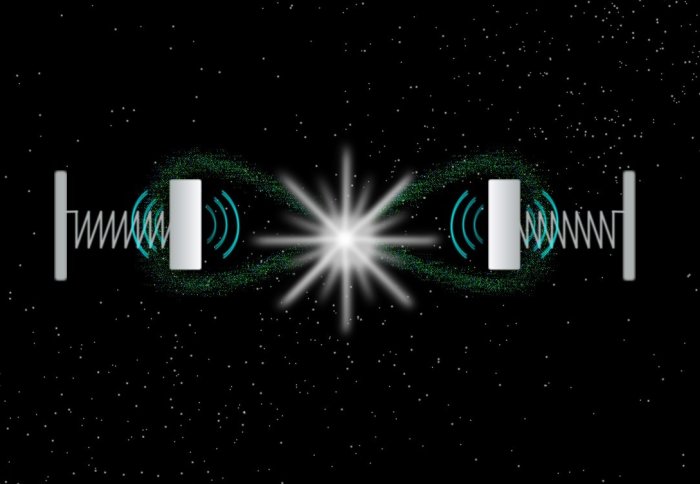How to entangle massive objects with short pulses of light

Researchers have proposed a new way to prepare quantum-mechanical entanglement between massive objects using short pulses of light.
A team of researchers from Imperial College London and Stockholm University have proposed a novel way to generate quantum entanglement between two massive objects, potentially leading to new applications such as quantum sensors with unparalleled precision and quantum networks for secure communications.
Quantum states behave differently when they are being watched and we use this to our own advantage. Dr Michael Vanner
Excitingly, their research also provides powerful new techniques to even test the limits of applicability of quantum theory itself. The details of the team’s research are published today in the New Journal of Physics.
Quantum entanglement is one of the most intriguing aspects of physics and allows objects to be more strongly correlated than is allowed classically. This means that when measurements are made on entangled objects, the measurement outcomes are linked in a way that cannot be explained without abandoning our everyday intuitions.
Einstein called this perplexing behaviour “spooky action at a distance” and many objections to this radical idea were raised during the early days of quantum theory. Fast forward 80 years, and quantum entanglement is now a well-established phenomenon that is routinely generated between objects such as photons, atoms, and molecules.
Generating entanglement
To generate entanglement between more massive objects, the team consider short pulses of light reflecting from a pair of small-scale mechanical oscillators that can be thought of as tiny mirrors on springs. Simply the reflection of light from one of the mirrors is sufficient to change its momentum, and the authors take advantage of the quantum properties of light to engineer quantum states of motion, bringing the humble mass-on-a-spring into the quantum domain!

Harnessing the interactions between light and mechanical oscillators is central to the new field of quantum science known as quantum optomechanics, which the current research contributes to and advances. It’s a very exciting time in optomechanics at present as quantum mechanical behaviour, including some types of quantum entanglement, is now being seen in laboratories across the globe.
Jack Clarke of the Quantum Measurement Lab, Imperial College London, tells us that “it is important that we develop optomechanical protocols to prepare quantum states of motion in new parameter regimes that are now becoming experimentally accessible”.
Flashes of light
More specifically, the present research introduces a novel scheme using short optical pulses to generate entanglement between light and a massive oscillator, as well as two separate schemes for entangling a pair of massive oscillators. These short pulses interact with the oscillators over a duration much shorter than a period of motion. “Each oscillator then sees just a flash of light and has no time to react before it knows what’s hit it!” says Paulo Sahium of the Quantum Measurement Lab.
To entangle two massive oscillators, the authors propose one scheme using an optical interferometer, which splits a pulse of light into two paths that each contain a mirror-oscillator, and a second scheme involving sequential interactions with two mirror-oscillators in a single optical path.
Central to these latter two schemes is the action of quantum measurement. “Quantum states behave differently when they are being watched and we use this to our own advantage,” says Michael Vanner, director of the Quantum Measurement Lab.
A clear route to observation
How can you then prove that the schemes have actually worked? To answer this question, the researchers have designed procedures to verify the amount of entanglement created, again using short pulses of light and optical measurements.
By using parameters from recent experiments, the researchers convincingly demonstrate that these new entanglement schemes are experimentally viable and robust to effects that often hinder the observation of optomechanical entanglement.
Thus, these results provide a clear route towards observing quantum entanglement in a regime where it hasn’t been seen before, and enable us to peer deeper into the quantum world with an ever more powerful lens.
-
'Generating mechanical and optomechanical entanglement via pulsed interaction and measurement' by Clarke, P. Sahium, K. E. Khosla, I. Pikovski, M. S. Kim & M. R. Vanner is published in New Journal of Physics.
Contacts:
Jack Clarke and Michael R. Vanner
Quantum Measurement Lab
Imperial College London
Article text (excluding photos or graphics) © Imperial College London.
Photos and graphics subject to third party copyright used with permission or © Imperial College London.
Reporter
Press Office
Communications and Public Affairs
- Email: press.office@imperial.ac.uk
